Two Tow Truck Drivers Killed When Struck in a Highway Breakdown Lane
Massachusetts Case Report: 04-MA-005
Release Date: May 22, 2006
Summary
On February 20, 2004, two male tow truck operators (the victims), ages 23 and 24, were fatally injured when a passing car struck them as they stood in the breakdown lane of a major interstate highway. Victim #1, the 23-year-old, was returning to the company office after towing a car with a conventional tow truck to a drop off location a few towns away. Victim #1 pulled into the breakdown lane when he noticed the tow truck’s alternator light was on and radioed the company office for help. Victim #2, responding to the call for help, drove a flatbed tow truck to the incident location. Both victims were standing on the left side of the trucks parked in the breakdown lane when a passing motorist crossed into the breakdown lane striking both victims and both trucks. A call was placed for emergency medical services (EMS) by passing motorists and EMS responded to the scene within minutes. Victim #1 was pronounced dead at the scene and victim #2 was transported to a local hospital were he was pronounced dead. The Massachusetts Fatality Assessment and Control Evaluation (FACE) Program concluded that to prevent similar occurrences in the future, employers should:
- Ensure that employees use the tow equipment control levers located on the side of the tow truck farthest from approaching traffic;
- Ensure that employees use portable emergency warning devices to help alert approaching motorists of the stopped emergency vehicles ahead;
- Supply and ensure that employees wear appropriate personal protective equipment, including high visibility vests when working along highways and streets;
- Develop, implement, and enforce standard operating procedures (SOP) for responding to highway and street incidents that include minimizing time spent on the side of the vehicle that is closest to approaching traffic; and
- Develop, implement, and enforce a comprehensive safety program that includes training on hazard recognition and avoidance of unsafe conditions.
In addition, policymakers should:
- Consider the feasibility of enacting a “mover law”.
Introduction
On February 21, 2004, the Massachusetts FACE Program noticed in the local media that, the day before, February 20, 2004, two tow truck drivers had been fatally injured while standing in the breakdown lane of a major interstate highway. An investigation was immediately initiated. On March 10, 2004, the Massachusetts FACE Program Director traveled to the office location of the automotive towing and repair company where the company owner was interviewed. The death certificates, corporate information, and police incident report were reviewed during the course of the investigation. In addition, photographs were taken of the incident location and the company trucks involved.
The employer was an automotive towing and repair company that had been in business approximately ten years at the time of the incident. Company-wide, they employed approximately 11 people, seven of whom held the job title of truck operator, the same job title as the victims. The company did not have a designated person in charge of safety, but did provide each new employee with a three-day training on towing vehicles. The main topics addressed during the training were driving the tow trucks and the process of loading and unloading different types of vehicles.
Victim #1 had worked at the company for approximately one year and held a previous job as a tow truck operator. Victim #2 had worked at the company for approximately six months and had no other towing experience. The employees did not have union representation.
Investigation
The trucks involved in the incident were a 1994 conventional tow truck (Figure 1) and a 1999 flatbed tow truck (Figure 2). Victim #1 was returning to the office, via a major interstate highway, after towing a car to a drop off location that was a few towns away. At approximately 3:30 a.m. victim #1 noticed that the conventional tow truck’s dashboard alternator warning light came. Victim #1 pulled the conventional tow truck into the shoulder/breakdown lane, angling the front of the truck away from the travel lanes and called the company office, via cell phone, for help. Victim #2 was dispatched by the office to respond to the co-employee’s call for assistance. Victim #2 headed out to the location of victim #1 in the flatbed tow truck to bring the broken down conventional tow truck and victim #1 back to the office.
The interstate was a six lane asphalt highway with an asphalt shoulder/breakdown lane and a grass median. The section of the interstate where the incident occurred did not have street lights, but it did have a right hand lane white fog line and a rumble strip inside the left hand side of the breakdown lane parallel to the white fog line. The section of interstate where the incident occurred was level and straight with a slight curve (Figure 3 and 4). At the time of the incident the section of highway was clear and dry.
At approximately 4:00 a.m., victim #2 arrived at the location where the conventional tow truck had broken down. Victim #2 pulled into the break down lane in front of the conventional tow truck and positioned the flatbed tow truck at an angle in front of the conventional tow truck. The flatbed truck was equipped with reflecting triangles, which were placed behind the disabled tow truck (at unknown distances), and with yellow strobe lights that were on at the time of the incident. The truck also had dual tow equipment control levers for the flatbed tow truck, one set was located on the driver’s side and the other set was located on the truck’s passenger side.
The victims were standing on the driver’s side (left side) of the trucks while preparing to load the broken down conventional tow truck onto the flatbed tow truck when a car traveling at a high rate of speed crossed into the breakdown lane. The car sideswiped the conventional tow truck and continued in the forward direction striking both victims. The car then struck and became wedged partially under the left rear section of the flatbed tow truck (Figure 5). The incident was reported to Emergency Medical Services (EMS) via cell phones calls from passing motorists. EMS arrived within minutes of the calls. Victim #1 was pronounced dead at the scene and victim #2 was transported to a local hospital were he was pronounced dead later that same day. The operator of the car was transported to a local hospital and sustained non-life treating injuries. At the time of the incident, the operator of the car was allegedly driving the vehicle under the influence of alcohol.
The company owner mentioned during the interview that it is up to the tow truck drivers if they feel they need assistance, such as requesting help from the state police, when picking up vehicles that are located highways. The company owner also stated that often tow truck drivers, when responding to an incident along a highway, will assess their surroundings and if they feel safe at that time, will use the tow equipment control levers on the driver’s side of the truck to save time. In addition, the company owner reported that the conventional tow truck had broken down because of a malfunctioning alternator. This malfunctioning alternator was a rebuilt alternator and had been installed less than one year prior to the incident. Since the incident, the alternator had been replaced with a new alternator.
Since this incident, although not due to this incident, a new Massachusetts law, “Melanie’s Law”, was enacted in October 2005. The purpose of this law is to enhance the penalties and administrative sanctions for Operating Under the Influence (OUI)offenders in Massachusetts.1
Cause of Death
The medical examiner listed the cause of death for victim #1 as multiple injuries and for victim #2 as severe blunt leg trauma.
Recommendations/Discussion
Recommendation #1: Employers should ensure that employees use the tow equipment control levers located on the side of the tow truck farthest from approaching traffic.
Discussion: The flatbed tow truck involved in the incident was equipped with tow equipment control levers for the flatbed tow truck on both the driver’s and passenger’s sides of the truck. In this incident the control levers being used at the time of the incident were the control levers located on the driver’s side of the truck, the side closest to oncoming traffic. Employers should ensure that tow truck operators, when feasible, use the control levers located on the side of the truck that are the farthest from approaching traffic.
Recommendation #2: Employers should ensure that employees use portable emergency warning devices to help alert approaching motorists of the stopped emergency vehicles ahead.
Discussion: Placement of portable emergency warning devices will help alert approaching motorists that there is a situation ahead. The company owner reported that the tow truck operators had the truck’s hazard warning signal flashers on along with the truck’s strobe lights and had placed reflective triangles at unknown distances at the incident scene.
The Federal Motor Carrier Safety Administration requires that, when commercial motor vehicles are stopped in traveled portion of highways or the shoulder of highways, the driver of the stopped commercial motor vehicle shall immediately activate the vehicle’s hazard warning signal flashers and keep them on until placement of the portable emergency warning devices are complete. The following placement of warning devices should be followed when commercial motor vehicles are stopped:3
- On two-lane roads with traffic in both directions, or on undivided highways, warning devices should be placed in the center of the lane or shoulder occupied by the commercial motor vehicle and at 10 feet and 100 feet in both directions from the commercial motor vehicle.
- Within 500 feet of a curve, crest of a hill or other object that is obstructing approaching motorists’ view, the warning device should be placed to provide ample warning to approaching motorists between 100 feet to 500 feet from the stopped commercial motor vehicle.
- On divided or one-way roads, warning devices should be placed in the center of the lane or shoulder occupied by the commercial motor vehicle and at 10 feet, 100 feet, and 200 feet from the rear of the commercial motor vehicle.
Recommendation #3: Employers should supply and ensure that employees wear appropriate personal protective equipment, including high visibility vests when working along highways and street.
Discussion: Tow truck operators face many hazards while working. They routinely are on foot working along highways and streets, bringing them close to roadway traffic with no barriers between them and the moving vehicles. They work in daylight and in darkness, both of which could limit their visibility to passing motorists.2
The U.S. Department of Transportation’s (DOT) Manual on Uniform Traffic Control Devices (MUTCD) states that all workers exposed to the risks of moving roadway traffic or construction equipment should wear high-visibility safety apparel.4 The MUTCD refers to the American National Standard Institute’s (ANSI) standard for High–Visibility Safety Apparel (ANSI/ISEA 107-1999). This standard, published by the International Safety Equipment Association (ISEA), recommends specific types of reflective equipment while working in or near moving traffic. This standard specifies three classes of garments based on the workers’ activities. These classes are:5
- Class 3 garments provide the highest level of visibility for workers who face serious hazards with high task loads that require attention away from their work where traffic exceeds 50 miles per hour (mph).
- Class 2 garments are intended for use where greater visibility is necessary during inclement weather conditions and when activities occur near roadways where traffic speeds exceed 25 mph.
- Class 1 garments (not for use along highways and streets) are intended for use in activities that permit the wearer’s full and undivided attention to approaching traffic. There should be ample separation of the worker from traffic, which should be traveling no faster than 25 miles per hour.
The standard also states that a competent person designated by the employer should be responsible for selecting the appropriate class of garment for the workers. A competent person, as defined by the Occupational Safety and Health Administration (OSHA), is a person who, through training or knowledge, is capable of identifying existing and predictable hazards in the surroundings or working conditions that are unsanitary, hazardous, or dangerous to employees, and who has authorization to take prompt corrective measures to eliminate them.
Recommendation #4: Employers should develop, implement, and enforce standard operating procedures (SOP) for responding to highway and street incidents that include minimizing time spent on the side of the vehicle that is closest to approaching traffic.
Discussion: When tow truck operators respond to areas along highways, they face multiple hazards, one of which is being struck by oncoming motor vehicles. These hazards are increased when responding to highways at night because the operators of the passing motor vehicles have reduced vision and consequently reduced reaction time. Standard operating procedures (SOP) for responding to highways for both light service calls and tows should be developed by employers with input from employees.
Standard operating procedures for towing vehicles should include, but not be limited to:6
- Positioning the tow truck in front of the disabled vehicle and then backing the tow truck straight up to the vehicle;
- Engaging the tow truck’s emergency brake and engaging power to the towing system;
- Spending as little time as possible on the side of a truck that is closest to traffic lanes;
- Facing and watching approaching traffic as much as possible; and
- Wearing high-visibility safety apparel at all time.
Standard operating procedures for light service calls should include, but not be limited to:6
- Positioning the tow truck to provide a physical barrier between the disabled vehicle and moving traffic by parking the tow truck approximately 20 feet behind and slightly closer to the traffic lane than the disabled vehicle;
- Positioning the tow truck at an angle with the front of the truck pointed toward the traffic;
- Turning the tow trucks steering wheel all the way to the right and engaging the emergency brake;
- Spending as little time as possible on the side of a truck that is closest to moving motor vehicles;
- Facing and watching approaching traffic as much as possible; and
- Wearing high-visibility safety apparel at all time.
In addition, Chapter Six of the MUTCD provides guidelines for the improved safety of personnel when working in or near moving traffic. All workers should be trained on how to work next to motor vehicle traffic in a way that minimizes their vulnerability.4
Recommendation #5: Employers should develop, implement, and enforce a comprehensive safety program that includes training on hazard recognition and avoidance of unsafe conditions.
Discussion: The employer did provide on-the-job and some classroom training to employees, but this training did not address all hazards involved in towing operations. A comprehensive written safety program that includes training on hazard recognition and the avoidance of unsafe conditions should be developed, implemented, and enforced by employers.
Employers should evaluate tasks performed by employees for all potential hazards and incorporate these identified hazards and their controls into hazard recognition training. At a minimum, hazard recognition training should include, but not be limited to: hazard identification, the avoidance of unsafe conditions, and the abatement of identified hazards. Specific health and safety training for tow truck operators should include, but not be limited to: how to work next to motor vehicle traffic in a way that will minimize exposure to moving vehicles; and the proper techniques for warning device usage, placement, and retrieval. Instructions to employees should include a specific direction that employees should not risk physical harm to accomplish tasks.
The training program content and the names and dates of employees completing the training should be documented and retained by the employer. Employers should ensure that the trainer who provides training is qualified through education and/or experience to conduct training. As a reference, a summary of the Occupational Safety and Health Administration’s (OSHA) draft proposed safety and health program rule, which discusses employee training, has been included at the end of this report.
Recommendation #6: Policymakers should consider the feasibility of enacting a “move over law”.
Discussion: A number of states including, but not limited to, Georgia, Iowa, Missouri, South Carolina, and Wisconsin, have developed, implemented and enforced some form of “move over law”7. Some of these laws mandate that, when motorists are approaching stationary emergency vehicles (note: not all statutes include tow trucks in the definition of “emergency vehicle”) that are displaying visible flashing lights, the motorist must reduce the vehicle’s speed, move to a lane that is not adjacent to the lane in which the emergency vehicle is located or move as far away from the emergency vehicle as possible. Some “move over” laws also state that, if changing lanes is not possible or could be unsafe, the motorist should reduce the vehicle’s speed, proceed with caution, and maintain a reduced speed through the area where the emergency vehicle is stopped.
References
- Massachusetts General Laws, Chapter 90. Motor Vehicles and Aircraft, Section 24. Driving while under influence of intoxicating liquor, etc.; second and subsequent offenses; punishment; treatment programs; reckless and unauthorized driving; failure to stop after collision.
- NIOSH 2001. Building Safer Highway Work Zones: Measures to Prevent Worker Injuries from Vehicles and Equipment, Department of Health and Human Services, Center for Disease Control and Prevention, National Institute for Occupational Safety and Health, DHHS (NIOSH) Publication No. 2001-128.
- Code of Federal Regulations, 49 CFR 392 Driving of commercial motor vehicles, Government Printing Office.
- U.S. DOT 2003. Manual on Uniform Traffic Control Devices (MUTCD), 2003 Edition, Revision 1, U.S. Department of Transportation Federal Highway Administration. http://mutcd.fhwa.dot.gov/external icon. Date accessed: 3/31/2006.
- ANSI/ISEA 1999. American National Standard for high-visibility safety apparel. New York, NY: American National Standards Institute, ANSI/ISEA 107-1999.
- University of Extrication 2003. Safe positioning while operating in or near moving traffic. http://www.myfirecompanies.com/filelock/1200416345Stete_Move_Over_Law_Summary.pdf. Date accessed: 5/17/2006. (Need login to view FireCompanies.com – 3/20/2013)
- Respondersafety.com. State “Move-Over” Law Summary.
http://www.respondersafety.com/Downloads/MoveOver/20071271643170.MoveOverLawsFactSheet.doc Date accessed: 5/17/2006. (Link updated 09/10/2008 – no longer available 4/8/2015)
Illustrations
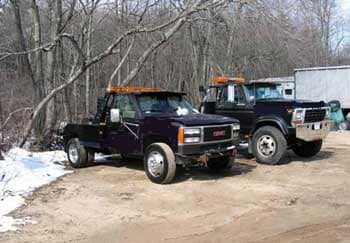
|
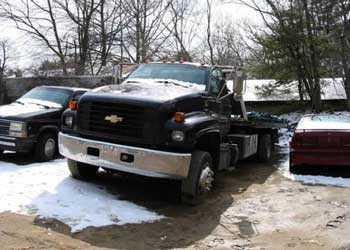
|
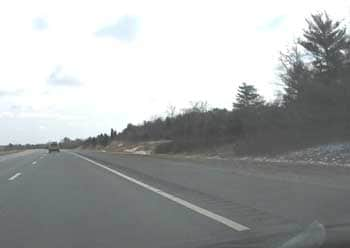
|
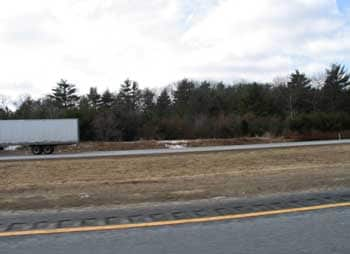
|
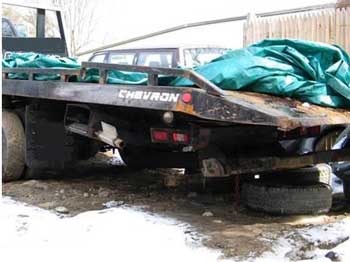
|
|
Figure 5. Location where the victims where standing and impacted of car.
|
To contact Massachusetts State FACE program personnel regarding State-based FACE reports, please use information listed on the Contact Sheet on the NIOSH FACE web site Please contact In-house FACE program personnel regarding In-house FACE reports and to gain assistance when State-FACE program personnel cannot be reached.
